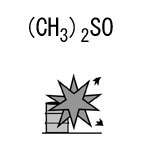| Case Name |
Explosion of a DMSO recovery drum caused due to foreign material contamination at an epoxy resin manufacturing plant |
| Pictograph |

|
| Date |
July 4, 1993 |
| Place |
Niihama, Ehime, Japan |
| Location |
Chemical factory |
| Overview |
Gas began to leak from a recovery drum of a solvent dimethylsulfoxide (DMSO) at an epoxy resin manufacturing plant for semiconductor encapsulation. The leakage intensified during conducting countermeasure work such as taking out some internal fluid, and the gas exploded. The recovery drum also exploded, and a fire spread. Foreign materials were contaminated for some reason, and an inadequate contamination reaction by miss-mixing occurred. On handling materials with a high reaction potential, it is important to carefully estimate danger with taking various possibilities into account. |
| Incident |
An explosion occurred at a DMSO recovery drum of an epoxy resin manufacturing plant. During usual operation, the contents of the vessel were discharged and cooled because the temperature of the DMSO recovery drum rose. However, the remaining contents violently spouted out and exploded. The DMSO recovery drum is a ten-cubic meter container with heat insulation using a heating coil.
DMSO: abbreviation of dimethyl sulfoxide. |
| Processing |
Manufacture |
| Individual Process |
Other |
| Substance |
Dimethyl sulfoxide, Fig2 |
| Epichlorohydrin, Fig3 |
| Dioxane, Fig4 |
| Type of Accident |
Leakage, explosion, fire |
| Sequence |
Gas leakage was detected from a breather valve of the DMSO recovery drum while epoxy resin was being manufactured. The solution's temperature rose from the normal 40°C to 78°C, which also raised internal pressure. As an attempt to stop the leakage from the breather valve, hot water of 90°C flowing through a coil in the drum was stopped, nitrogen for purging was stopped, some of the contents were drawn off, and cooling water was introduced into the coil. However, there was no effect. The leakage from the breather valve intensified, and an explosion occurred. In addition, organic solvents leaked from broken piping and caused a fire. |
| Cause |
Decomposition reaction was caused by a runaway reaction of DMSO due to contamination of foreign materials such as epichlorohydrin in the DMSO recovery drum. It is assumed that contamination occurred due to leakage from the block valve of piping that connected a storage tank for epichlorohydrin and dioxane with the DMSO recovery drum. |
| Response |
Fire fighting using water was performed by firemen. |
| Countermeasures |
1. Confirmation of danger based on safety data and evaluation tests of raw materials and so on.
2. Review of operation conditions based on dangerous characteristics of materials.
3. Separation of the control room from manufacturing facilities.
4. Strengthening of facilities to prevent a fire from spreading, and adoption of a remote control system. |
| Knowledge Comment |
Accidents in a chemical industry, which manufactures raw materials with various applications, can have significant effects on other industries positioned downstream of the manufacturing chain, in addition to material damage, casualties, and environmental impacts. Therefore, it is necessary to take sufficient disaster countermeasures into account. |
| Background |
Although various reaction accidents had occurred in the process of handling DMSO, related information was not properly shared. In addition, there seemed to be a lack of awareness of possible leakage from valves, thus sufficient attention was not paid to seat leakage of a valve. |
| Sequel |
The plant was the world's largest manufacturing base of a key semiconductor material. Although the accident worried the whole electronics industry, the impact was limited because it restarted operation relatively quickly. |
| Reason for Adding to DB |
Example of explosion having a great impact on related industries due to operation stop of the plant |
| Scenario |
| Primary Scenario
|
Organizational Problems, Inflexible Management Structure, Insufficient Education/Training, Insufficient Analysis or Research, Insufficient Practice, Lack of Imagination, Planning and Design, Poor Planning, Bad Event, Chemical Phenomenon, Abnormal Reaction, Secondary Damage, External Damage, Explosion, Failure, Large-Scale Damage, Leakage, Secondary Damage, External Damage, Fire, Bodily Harm, Death, Bodily Harm, Injury, 3 person injured, Loss to Organization, Economic Loss, Manetary Damage 1500 million yen, Damage to Society, Social Systems Failure, Big Blow to Semiconductor Manufacture
|
|
| Sources |
Fire and Disaster Management Agency, Fire and explosion at epoxy resin manufacturing plant. Accident cases of dangerous materials. 1993, pp.108-110.
Niihama City Fire-Defense Headquarters. S chemical E factory. Fire-fighting operation at the epoxy resin manufacturing plant explosion. Monthly fire fighting. No.172, pp.76-81(1993).
The epoxy resin plant explosion in S chemical E factory. Industry and protection. Vol.9 No.26. p.7(1993)
|
| Number of Deaths |
1 |
| Number of Injuries |
3 |
| Physical Damage |
A four-story building with a steel frame and a slate roof of about 650 square meters used for manufacturing was partially damaged by fire. A recovery drum was destroyed and scattered. The roof of the building, tiles on the wall surface, zinc-coated steel, and windows were damaged. Windows and roofs of houses located within a radius of about 1.5 km of the site suffered damage. |
| Financial Cost |
¥ 1,500 million (Fire and Disaster Management Agency) |
| Multimedia Files |
Fig2.Chemical formula
|
|
Fig3.Chemical formula
|
|
Fig4.Chemical formula
|
| Field |
Chemicals and Plants
|
| Author |
WAKAKURA, Masahide (Kanagawa Industrial Technology Research Institute)
TAMURA, Masamitsu (Center for Risk Management and Safety Sciences, Yokohama National University)
|
|